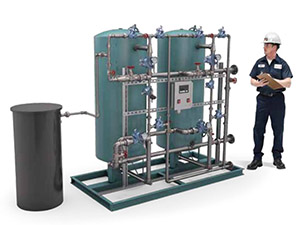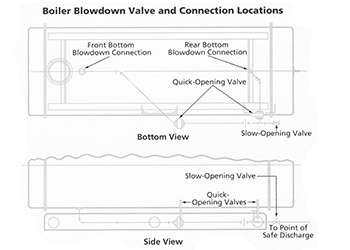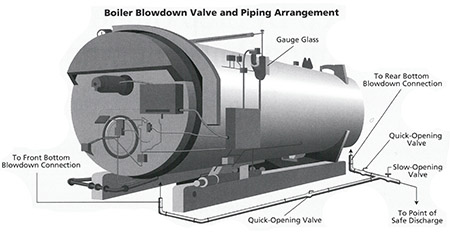
Following proper procedures to remove sludge and maintain a predetermined solids concentration maximizes performance and minimizes repairs
Written by Andrew S. Barrieau, Technical Services Manager, Cleaver-Brooks
A boiler is blown down to control the amount of solids and sludge in the boiler water. An excessive amount of solids and sludge can insulate the heating surfaces on the waterside of the boiler. The metal overheats, and as a result, the pressure vessel fails. High solids concentrations also can lead to carryover of the boiler water into the steam, which can cause water hammer and damage piping and equipment. It can also result in low water conditions in the boiler.
The blowdown process involves partially draining the boiler to remove sludge and maintain a predetermined concentration of solids so that boiler performance is maximized and maintenance and repair costs are held to a minimum. It is expensive to maintain low solids concentrations in the boiler because each gallon of blowdown water has already been heated and treated.
When boiler water turns to steam, solids are left behind. Unless the condensate return is 100 percent, the solids content tends to build up when the boiler takes on makeup water. (On hot water systems, no makeup water is generally used. The solids concentration remains the same and no blowdown is needed.)
Check Components
The amount and frequency of blowdown differs for each boiler application. These should be determined in consultation with a water management consultant. Various factors affect blowdown. They include type of boiler, operating pressure, water treatment and amount and quality of makeup water.
Blowdown piping should be at least the same size as the blowdown tapping on the boiler. Blowdown valves should be sized according to ASME code and piped to a safe point of discharge. The system should be equipped with either two slow-opening valves or one quick-opening valve piped in series. If the boiler has more than one bottom blowdown connection, a second quick-opening valve is needed. However, both quick-opening valves can be piped to a common header and slow-opening valve, Fig. 1.
 Fig. 1. Schematics of the bottom and side views of a boiler show the placement of quick-opening and slow opening blowdown valves. Front and rear blowdown connections are also visible on the bottom view. Because this unit has two blowdown connections, two quick-opening valves are used. Both devices are piped to a common header and slow-opening valve.
Fig. 1. Schematics of the bottom and side views of a boiler show the placement of quick-opening and slow opening blowdown valves. Front and rear blowdown connections are also visible on the bottom view. Because this unit has two blowdown connections, two quick-opening valves are used. Both devices are piped to a common header and slow-opening valve.
A slow-opening valve is defined as one that needs five complete 36-degree turns to go from fully closed to fully open. A quick-opening valve goes from fully closed to fully open in one complete motion. If both types of devices are installed, the quick-opening valve(s) should be placed closest to the boiler. Whenever possible, blowdown valves should be piped on the same side of the boiler as the water column gauge glass, Fig. 2.
 Fig. 2. For proper blowdown, a boiler should be equipped with either two slow-opening valves or one slow-opening valve and one or more quick-opening valves piped in series. If both types are installed, the quick-opening device(s) should be placed closest to the boiler. The valves should be piped on the same side of the boiler as the water column gauge glass.
Fig. 2. For proper blowdown, a boiler should be equipped with either two slow-opening valves or one slow-opening valve and one or more quick-opening valves piped in series. If both types are installed, the quick-opening device(s) should be placed closest to the boiler. The valves should be piped on the same side of the boiler as the water column gauge glass.
Use a Step-by-Step Procedure
The following steps should be taken to blow down a boiler.
- Open the quick-opening valves (ones closest to the boiler).
- Open the slow-opening valve.
- Blow down the boiler for the amount of time specified by your water management consultant by opening and then closing the slow-opening valve. Pay close attention to the water level in the gauge glass. Some loads require several, short blowdown cycles to maintain the proper water level in the boiler.
- Close the slow-opening valve.
- Close the quick-opening valve(s).
- Open the slow-opening valve again to drain the line between the quick and slow-opening valves.
- Close the slow-opening valve again and double check that the shutoff is tight after the valve has cooled off.
Never pump a quick-opening valve to blow down the boiler. Such action could cause water hammer and damage piping and valves. It could also cause personal injury. Never leave an open blowdown valve unattended.
Remember that the quick-opening valve(s) (those closest to the boiler) must be opened first and closed last. This procedure protects the valves from the wear associated with blowdown and keeps them more reliable. In addition, maintenance and repair can be performed on the slow-opening valve farthest from the boiler without having to drain the boiler.
Originally printed in Plant Engineering August 1995
© 1995 by Cahners Publishing Company




